September 14th, 2009 · No Comments
As a five year old, I preferred the swingset in my backyard to the television (unless the Power Rangers was on…but that is not important). As a seventeen/eighteen year old, I gained a whole new appreciation for the outdoors thanks to Valley Forge Park – the enormous, deer-ridden oasis in the middle of suburban Pennsylvania, home to hikers, bikers, picnics, and monuments (telling the park’s oft-told story when it was home to the Revolutionary Army). I have stayed in that park for hours on end – reading, laying, walking, and just being lazy. The ability to lay out on the grass surrounded by huge trees brought me closer to nature and the elements.
I should take a step back. I am not a hiker, nor do I spend every day longing for the outdoors. I am not about to mimic Christopher McCandless’ journey through Alaska and “Into the Wild”. Sure, I enjoy spending summer afternoons outdoors. Yes, I will absolutely take a trip to the park over a movie. That’s about as far as I go, though. That said, London’s parks immediately appealed to my sense of nature. They were beautiful and awe-inspiring. Only 48 hours prior to this post, I told a whole group of people that I could spend every day in these parks as long as I had a book in one hand and a warm drink in the other.
After closer investigation and reflection, I begin to wonder if these parks are not as idyllic as I had thought.
The parks in London have very different personalities. How can a park have a personality? Consider the sprawling grassy area of Regent’s Park. This area houses limited (if any) space for concert venues – the only area that sticks out is a playground for children. Rarely anyone takes a seat on the well-kept grassy areas (This was shown by the looks of confusion and sounds of incredulity as people passed by as we discussed Mrs. Dalloway and the Blitz.).
This directly contrasts with the immediate impressions of the even larger Hyde Park, which has areas that remain overgrown, raw, and certainly less manicured than other Royal Parks. Perhaps this is a reason this park is used more often for big venues and frequented by large crowds. Regardless, the park gives off a much more functional and natural, for lack of a better word, perspective of nature. Now Maddie will briefly discuss the importance of recreation in the three parks that I have just described.
“The Regent’s Park consists of two circles, which are intended to communicate with each other, but an experienced person is sometimes puzzled to discover how. The houses which nearly surround the outward ring are looked upon as wonders of architectural design and execution. The liberality of the genius employed is manifested in the generous conglomeration of style which is everywhere apparent. The Corinthian and Ionic are continually contrasted with the simple Doric and the street-doric.” -1842
These are the first few comments given by locals who visited Regents Park around the time it was first established in the early 19th century. The area was beautiful even then, filled with flowers and beautiful buildings encompassing the wide-open spaces. Yet, when I think of “parks” I imagine people running, playing frisbee, riding bikes, and enjoying the sunshine. I imagine laughter, games, and little kids. However, from my numerous visits to Regents Park (as well as St.James’s), I really haven’t noticed this kind of innocent, healthy fun like I have in Hyde Park. Therefore, in this part of our blog, I’ll discuss what is acceptable recreation in a these three London parks.
In Regents Park, as Brandon noted before, there was plenty of open space but few people laying the grass (such a crime). Even during our class discussions outside, I noticed many runners but few families taking little kids on picnics, playing tag or simply running around. The runners themselves ran through the beautiful park but seemed too focused on their exercise to really pay attention to the beautiful landscape. Or maybe that is just what Regents Park is to them: a beautiful landscape, a perfect and idyllic area to safely run through, but never stop to take in. Therefore, Brandon and I came to realize that although this park is majestic and lovely, it lacks a purpose. Parks are meant to be more than simply a gorgeous place to jog about, they are meant to be used to relax, catch time for oneself, and rejuvenate and quench the soul’s longing for peace and quiet amidst the busy city life.
St. James’s Park acted very similarly, though arguably more unfriendly than Regents Park. In my own personal experience at St. James’s, I found it to be “stuffy” so to speak. The grass was trimmed perfectly; the walkways clean, the pigeons even kept away. We had to pay to sit in the chairs. I visited the website that describes St. James’s Park and of course the web designers discuss the picnics in the park, the alcohol served in the restaurant in the middle of the park, the outdoor activities that take place, and the free concerts. Yet still no bikes are allowed, ball games are restricted to specific areas of the park, and people may only gather together in at very most groups of 20 to avoid “over-crowding”—this means our humanities group would not be allowed to sit and hold class there and enjoy the surroundings.
The final park that we decided to discuss was Hyde Park which both Brandon and I found to be the most “park-ish” if I may. This means that we both felt it to bring in a wider variety of people, allowing and encouraging more recreational activity. We also noticed more people strolling around the extensive 350 acre landscape instead of just running through. Another plus is that everything about this park is free; you don’t need to pay to sit in chairs or benches and you don’t need to pay to enter. Hyde Park also contains the Serpentine Lake, a spot for swimming, boating, picnicking and fishing and it is open to the public to use often. Also, Hyde Park is host to a variety of free concerts during the summer and encourages people to visit, both locals and tourists.
Overall, recreation is an important part of any park. However some parks are more successful at creating an atmosphere in which a diverse group of people are welcome to sit outside and enjoy nature. Instead most of these parks boarding on feeling rather synthetic and fake (excluding Hyde) and therefore we were interested to see how each of these three parks incorporated and valued recreational activity.
Tags: Brandon · Maddie
There are a total of eight Royal Parks within all greater London: St. James’s Park; The Green Park; Hyde Park; Kensington Gardens; Richmond Park; Greenwich Park; The Regent’s Park and Bushy Park. Thus far, I have visited three of these: St. James’s Park; Greenwich Park and The Regent’s Park. Each park was very different, yet shared a similar history.
St. James’s Park, originally created by King Henry VIII as a personal deer park for hunting, is located in Westminster. The park has been remodeled several times, including once for King Charles II in the 1600’s and again in the first half of the 1800’s by John Nash. The closest tube stops include Piccadilly Circus, Charing Cross and, of course, St. James’s Park.
This park is absolutely massive. You could easily spend an entire day here. Perhaps the most interesting feature of this park is its wildlife. There were waterfowl of all kinds paddling and preening in around the long lake that stretches through the park and placards along the way that discussed each species. The asphalt walkways circling the lake contain markers that indicate that the Princess Diana Memorial Walk trails through the park. With all the flora and fauna found inside St. James’s Park, it only seems appropriate to commemorate one of Great Britain’s most beloved members of the royal family here, amidst such beauty.
St. James’s Park is a popular spot for tourists and locals alike. There were many families, especially, snapping pictures of the scenery, but also native Brits jogging or enjoying lunch or a book in the park. What I did find interesting was that there were very few non-whites in the park. I remember seeing one tourist family of what appeared to be an Indian descent inside the park, posing for family snapshots by a knotty tree, and a two black women with strollers and little, skipping girls around the age of five, who walked along the sidewalk on the outskirts of the park, but never entered it.
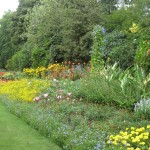


Greenwich Park is equally interesting. We walked through this park on our way to The Royal Observatory, which is located almost in the center of the park. The Observatory was commissioned by King Charles II (see hyperlink above) in 1675 and was designed by Christopher Wren, the architect who was responsible for countless famous buildings around London including St. Paul’s Cathedral and others circa the Great Fire of 1666. The park is inaccessible via the tube, but many buses such as the 188 and 53 run through Greenwich at frequent intervals.
This park, which is divided by the Prime Meridian features much more open space than either St. James’s or The Regent’s Park. There are large expanses of lawns – slightly browning in areas – with trees dotting the landscape throughout, but no fences, hedges, walls or other structures that create intimate spaces within the park. As we walked through the park I noticed many families and couples strolling through the park, and several joggers. There was a friendly yet rather skinny dog sniffing around the sneakers of several students. He carried a ball in his mouth and seemed to plead with his icy blue eyes for a playmate. He wandered around without direction and I wondered if he was blind, or homeless, and watched the ribs shift under his taut skin.
The abandoned dog, the slightly sunburned grass and the lack of flora cast a feeling of melancholy upon me as I walked through the park. I didn’t feel joy or peace in Greenwich Park as I did in St. James’s or The Regent’s Parks. Even the view of the city from the top of the hill upon which the observatory is situated depressed me. It is a view full of skyscrapers, power plants, power lines, smoke stacks no longer in use. When I am in the city for too long, I crave green space, but in Greenwich Park, I found myself preferring the city.
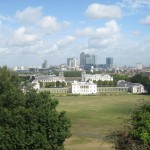
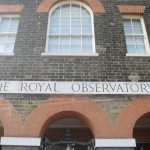
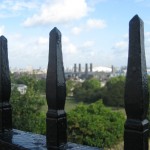
The Regent’s Park, located between Paddington and Camden Town, is accessible via several tube stops, including; Marylebone, Great Portland Street and, of course, Regent’s Park. The park was originally another of King Henry VIII’s deer gardens (see hyperlink above) and features the Queen Mary’s Garden, an area of the park blooming with over nine thousand begonias.
The Regent’s Park is one of the most stunning places, if not the most, I have been lucky enough to visit in my life. The walkways reach out through rows of shaped cylinders of shrubbery and tall hedges line the walkway, creating walls of green that flank beds of bright flora. Fountains pour out clear water that glints in the sun, cascading like icicles ripped from rooftops in the winter. There are areas reserved strictly for children, areas with cafes, an outdoor amphitheatre and a community sports and recreation centre. The overall feeling that I had being in the park was one of peace and serenity. Car horns, sirens, the pounding of joggers’ feet and the wails of children with scraped knees or simply a poor temperament could not be heard in the near silence of the park. For one who is quick to grow weary of the London hustle-bustle, The Regent’s Park serves as the quintessential getaway.
All of the Royal Parks I have visited thus far each have their own distinguishing characteristics, and a unique essence. But don’t take it from me. Hope on the tube and go find yourself some green.
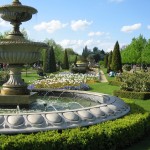
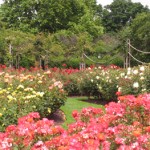
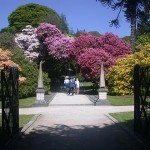
Tags: Anya
I am constantly finding myself in awe of something new in or about London. This morning’s subject of choice; statues. London has more statues than any other city I’ve ever been in, and I’ve visited my fair share. It’s not just the free-standing statues of Abraham Lincoln, Nelson Mandela, Winston Churchill, or General Montgomery that I saw just this morning, but also the finely-carved monuments and memorials to the Women of World War II, the Guard’s Memorial, and the Cenotaph. However, the greatest haven to carving in the British Isles I’ve encountered yet is Westminster Abbey.

- Westminster Abbey
Westminster Abbey is stuffed to the gills with statues and monuments to famous dead Britons. Sure, it’s kind of neat to see and praise the wonders of gravity at Sir Isaac Newton’s monstrous memorial, but is it really necessary for him to have such a large grave in a church full of other important people? On the flip-side to Newton’s tomb, Charles Dickens was buried in a very simple plot of ground… erm, church floor… that only recorded his name, date of birth, and date of death. Plain and simple, but did he really have any good reason for being buried in Westminster Abbey other than being a famous author? I was confused as to why these people, albeit extremely important in their own rights, would be buried in a place where they would have little-to-no affiliation with the Kings, Queens, and other nobles interred or no real connection to the Anglican faith. On that note, I also couldn’t help but wonder if any of the people buried at Westminster before the formation of the Church of England would be appalled to know their permanent resting place changed faiths on them! (Random thought, I know.)
After leaving Westminster, a group of us decided to go explore St James’s Park. As this was my first London park, I don’t have very much to compare it to. There were people everywhere posing for pictures, feeding the birds, chattering on in their native languages, and relaxing on park benches. The thing that struck me most about St James’s Park was the landscaping of gorgeous, brightly coloured flowers. They were so well tended-to and made the experience of strolling along extremely pleasant! There were also ponds with numerous types of water fowl and educational signs that showed pictures of what animals are indigenous of the area. However, due to the close proximity of Buckingham Palace and the Diana, Princess of Wales Memorial Walk located in the area, St James’s Park is definitely a bustling tourist attraction.

Flowers from St James's Park

Diana, Princess of Wales Memorial Walk
Just off of St James’s Park is the Churchill Museum and Cabinet War Rooms. I am a big fan of the history of Britain during World War II and the Blitz, so I was really looking forward to climbing into the depths of Churchill and the Cabinet’s own bunker. Thankfully, I was not disappointed! There was something very surreal about walking through the rooms with the provided audio guide and standing just feet away from where some of the most influential and comforting speeches of WWII were made by Winston Churchill.
However, the entire experience was not all sunshine and daisies. I had a big issue with the part of the bunker devoted to the Churchill Museum. Churchill was not a saint, please do not make him out to be one. There was little-to-no information provided on Churchill’s faults throughout the entire museum. I like Churchill as a historical figure and find much of what he accomplished in his various offices simply incredible, but he screwed up on more than one occasion. I was particularly frustrated with the portrayal of Churchill during the Dardanelles campaign during World War I. Churchill was the First Lord of the British Admiralty and in an attempt to “bring an end to the war quickly,” he sent Anzacs into battle poorly equipped and with incorrect maps. Although Churchill did resign in the aftermath, the museum would lead you to believe that the entire catastrophe that led to the loss of so many Anzac lives was not at all Churchill’s fault. (I also would have liked any information on Churchill’s relations with Ireland at the time of the Blitz, but alas, apparently it was not deemed as important.)
My day went from a fascination with statues in Westminster Abbey to walking in a building encased with steel and concrete. Although these things seem to be quite different on the surface, there is something that connects them; Churchill. They were Winston Churchill’s War Rooms and the Abbey bears a plaque commemorating Churchill. There is more than just this surface comparison, though. In times of great need, people turned to Churchill and to their church for reassurance.
Tags: Kelley












